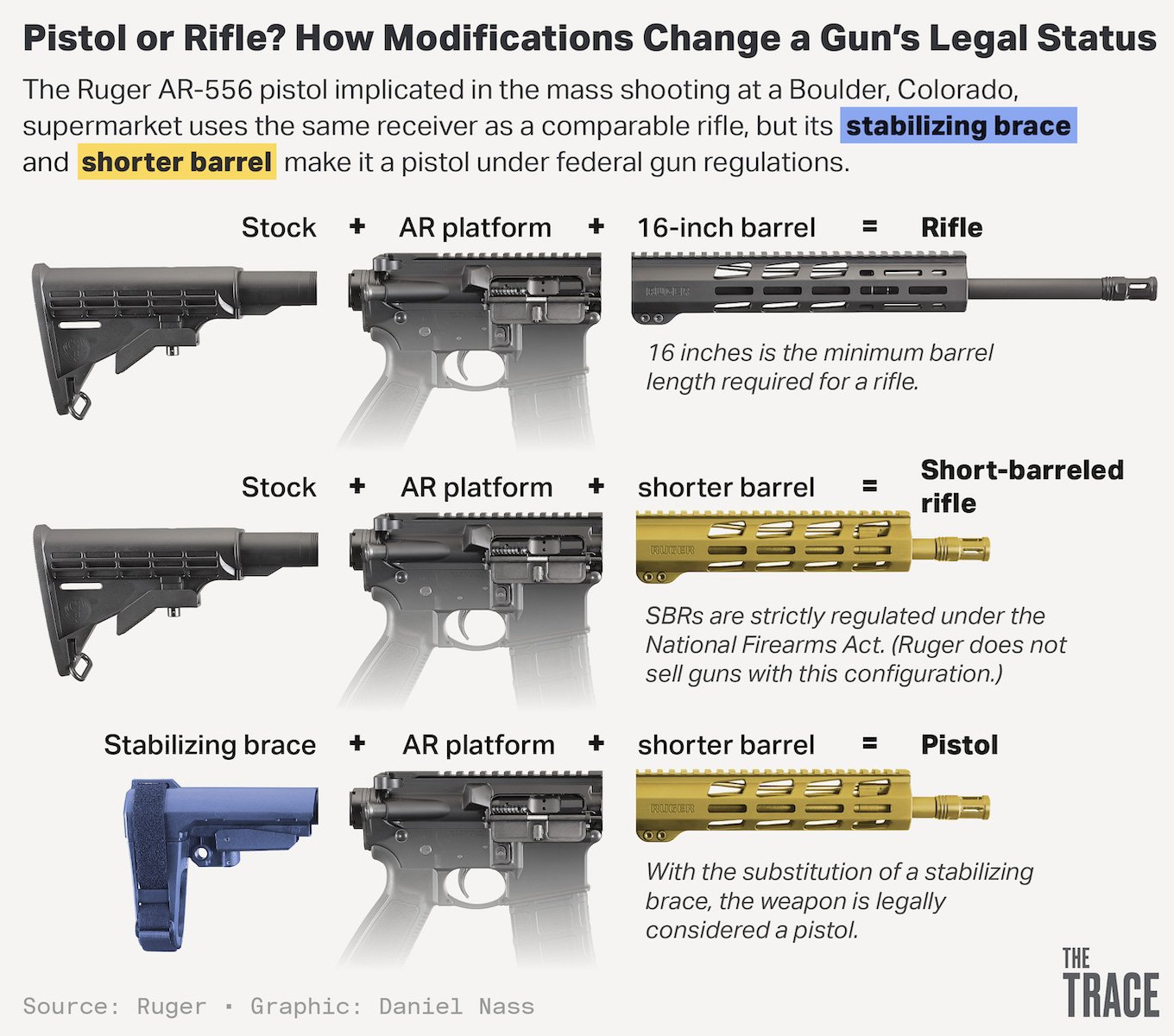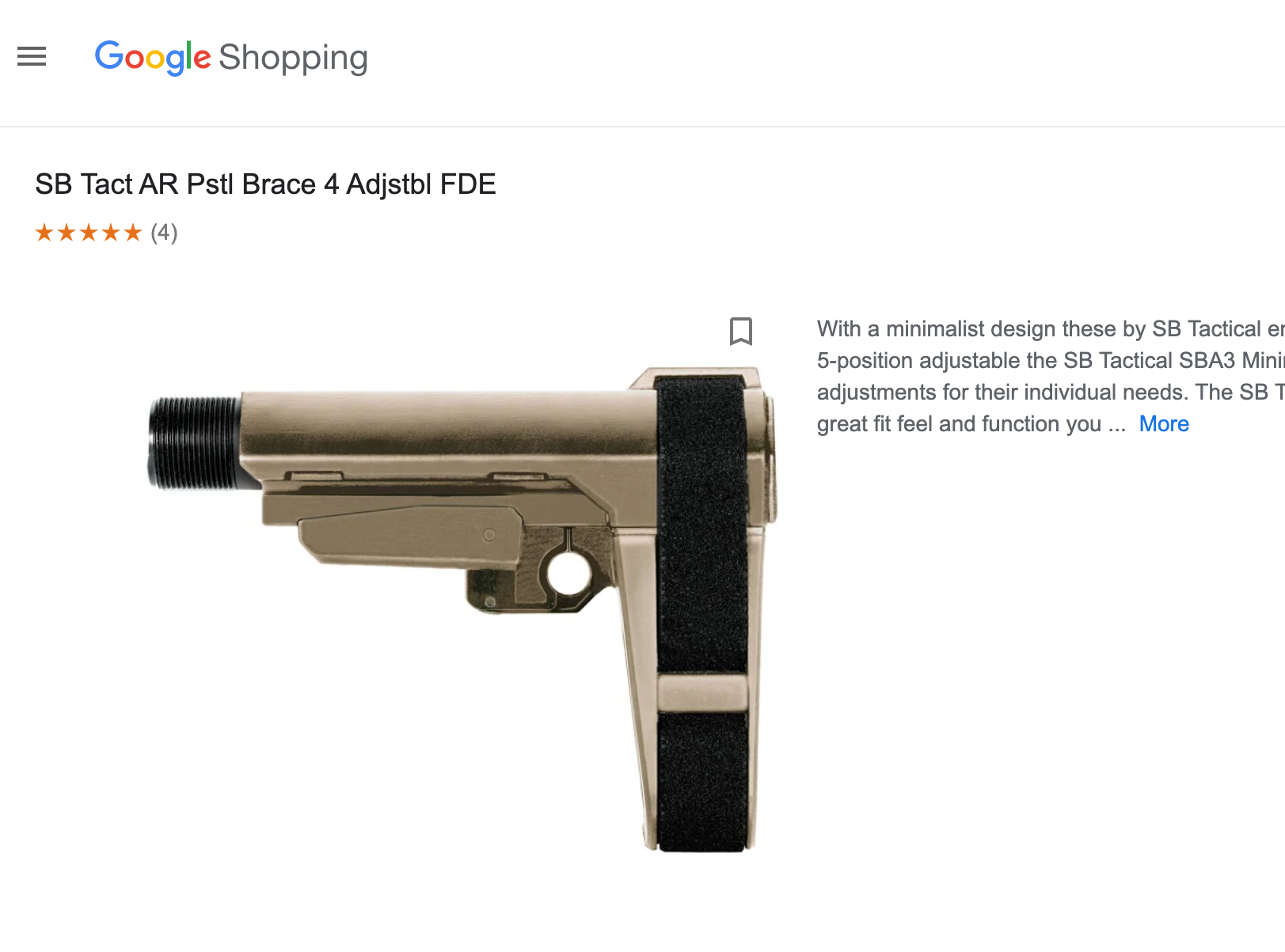President Joe Biden’s Department of Justice is moving forward with a pledge to clamp down on pistol-stabilizing braces after the popular gun accessory was used in the March mass shooting in Boulder, Colorado.
But the plan put forward by the administration this summer will hinge on the efficiency of an obscure division at the Bureau of Alcohol, Tobacco, Firearms and Explosives that routinely misses its own performance benchmarks. And now, with millions of stabilizing braces estimated to be in circulation, some outside observers are warning the efforts to restrict them could flounder if federal regulators are unable to handle the workload.
The rules, which were proposed in June, would bring stabilizing braces under the purview of the National Firearms Act, an 87-year-old law that imposes tight restrictions on machine guns, silencers, rifles with short barrels, and other weapons deemed by Congress to pose an acute threat to public safety. If the rules come into force, gun owners seeking to attach a stabilizing brace to their pistol would have to obtain approval from the ATF’s NFA Division. That process can stretch more than a year and entails filing an application, undergoing extensive vetting, paying a $200 tax, and registering the weapon with the federal government. Violations can result in a 10-year prison term.
Mark Jones, a former ATF special agent who held various supervisory positions before retiring in 2011, said the rule change could trigger an avalanche of NFA applications for a division that is underprepared. “ATF’s been so poorly funded and resourced over the decades that it doesn’t have the people it needs,” Jones said. “If they just snapped their fingers and said, ‘Tomorrow all of you have to register these weapons or you’re felons,’ it would fail in a huge way.”
Between 2012 and 2020, NFA applications more than tripled, from about 152,000 to nearly 500,000. The ATF struggled to keep pace and repeatedly warned Congress about the need for more staff. At one point, the division had fallen so far behind that investigators who normally would have been inspecting gun stores were instead assigned to assist with NFA tasks. The bureau told lawmakers that in 2019 there were 29 examiners working at the NFA Division, and that is the latest number available. Examiners had a goal of processing applications within 90 days, but they missed it in about four out of five cases.
The ATF, Jones said, “has always had to rob Peter to pay Paul to do any sort of major project.” The resource shortage is not an accident: For decades, gun lobbyists on Capitol Hill have worked to block funding and curtail the ATF’s enforcement powers. The gun industry “wants the agency there so they can say they’re regulated,” Jones said. “And they want the agency there as a whipping boy when something goes wrong. They need a bogeyman for the people who don’t understand how these things work.”

Delays at the NFA Division are so notorious that gun rights advocates have created websites to monitor processing times. NFA Tracker — which compiles anecdotal reports from applicants — shows some of them waited 13 months for a response. In a thread on Reddit, one user rejoiced when his application was approved in less than three months. “This gives me hope,” the user said.
So many pistol braces have already been sold that any regulations would need to be phased in over time, Jones said. There have been precedents for this: In 2018, the ATF effectively banned bump stocks — attachments that increase the rate of fire for semiautomatic rifles — after they were used in the 2017 Las Vegas mass shooting, which killed 60 people. In 2006, the ATF reversed course on a bump-stock-like device called the Akins Accelerator, and in 1994, combat shotguns, like the Striker-12 and the Street Sweeper, were declared destructive devices and placed under NFA regulation. But those retroactive restrictions affected thousands of weapons and devices, not millions.
Erik Longnecker, an ATF spokesperson, acknowledged the increase in NFA applications over the last decade had lengthened response times, but he said the bureau had “expended considerable resources” to streamline the process. This included making it easier to file applications electronically. Longnecker also said the bureau has hired more examiners and contract staff, though he declined to say how many. “As a matter of policy, ATF does not comment on personnel and staffing assignments,” he said.
As The Trace has previously reported, the ATF tried to regulate pistol braces once before, publishing a similar rule last December, but the bureau abruptly abandoned the effort after criticism from congressional Republicans. So far, the new rule has garnered more than 119,000 comments over the last five weeks, many of them critical. The public comment period ends September 8.
Jim Willi, a Texas attorney who specializes in helping clients with NFA applications, said brace owners bought their accessories thinking they would never have to grapple with NFA barriers. “The ATF said this is OK… and now they’re suddenly changing their mind,” Willi said. “Millions of pistol brace owners have been led down this path.”
Stabilizing braces hit the market about a decade ago. Originally billed as an aid for shooters with disabilities, the braces were designed to be attached to the rear of an assault-style pistol and affixed to the user’s forearm, increasing accuracy while firing with one hand. But gun enthusiasts quickly realized the braces functioned as de facto shoulder stocks, effectively turning their pistols into short-barreled rifles — which are subject to NFA controls.
The advent of stabilizing braces has increased consumer demand for assault-style pistols, which are weapons that blend the concealability and maneuverability of a handgun with the increased firepower and capabilities found in tactical rifles and submachine guns. Many assault-style pistols are visually and mechanically similar to a short-barreled rifle but the ATF classified them as handguns because they lack a stock, the component that enables shooters to shoulder their rifles while firing.
Chelsea Parsons, vice president of gun violence prevention at the Center for American Progress, co-authored a report in 2020 calling short-barreled rifles “a looming public safety crisis.” She says assault-style pistols are also dangerous because they are easily concealable and fire rounds capable of piercing police body armor. Attaching a brace increases the potential lethality by allowing users to shoulder the pistols and aim and shoot more easily.
Shooters, gun sellers, and critics of pistol braces have pointed out that brace-equipped pistols provide an option for shooters looking to obtain NFA-like weapons without having to jump through the law’s hoops. As the popularity of stabilizing braces soared, gun companies seized the opportunity and began offering consumers a bevy of pistols with braces already attached.
Parsons said stabilizing braces were a clear attempt by gun companies to circumvent the NFA. “The gun industry has largely been able to innovate around the law and pump out whatever they want with very little pushback from ATF,” she said. “It’s really important that ATF, as the agency responsible for implementing the NFA, keeps pace with industry innovations and makes sure that gun companies aren’t putting products out in the consumer market that are really designed to undermine NFA regulations.”
Michael Cargill, who owns the Central Texas Gun Works store in Austin, said stabilizing braces have become commonplace over the years. “Multiple times throughout the week someone will pick one up from us,” he said.
Cargill, a Black disabled Army veteran who says he has benefited from using a pistol brace, sued the ATF when it moved to ban bump stocks. He said the proposed brace regulation has him worried that law enforcement will use it to rack up easy gun charges on poor and minority communities.
“In reality, when it’s applied, it’s going to go after low-income individuals,” Cargill said. “It will continue to be a tool that law enforcement uses to do what we know happens in this country on the other side of the tracks.”
Stabilizing braces began generating controversy after a gunman used one with an assault-style pistol to kill nine people outside a Dayton, Ohio, bar in August 2019. Then, in March, it emerged that the perpetrator who fatally shot 10 people at a Boulder, Colorado, grocery store was armed with a Ruger AR-556 pistol sold with a pre-installed brace.
The precise number of pistol braces in circulation is unknown. The ATF estimates that between three million and seven million braces have been sold since 2012. The Congressional Research Service, meanwhile, reported “unofficial estimates” of between 10 million and 40 million braces “either purchased as accessories or already attached to firearms made at home or at the factory.”
Congress enacted the NFA in 1934 in hopes of limiting ownership of machine guns, silencers, and other select guns and gun parts by making them more difficult and expensive to purchase. The $200 tax levied on NFA weapons was prohibitively high for many people at the time, but it hasn’t changed since then. (If it had kept pace with inflation, the tax would be more than $4,000 today). The strategy largely worked, and in the decades following the law’s passage, NFA weapons became a rare sight at crime scenes. One analysis of federal gun prosecutions between 1995 and 2005 found only 153 cases in which a silencer was involved in a crime, and most of those charges were for criminal possession.
ATF officials have attributed the NFA application surge in recent years to states rolling back restrictions on short-barreled rifles and silencers. Silencers — also known as suppressors — are now legal for hunting purposes in 40 states, up from 22 states a decade ago, according to the American Suppressor Association, a trade group. Meanwhile, the number of silencers registered with the ATF jumped from about 285,000 in 2010 to more than 2 million in 2020.
Parsons said one way to alleviate the NFA backlog is by putting the entire application process online and eliminating paper forms entirely, something that would “speed up the process quite a bit.” Another, more obvious solution: funding to hire more staff.
“You have an agency that’s overwhelmed, and you have a division of the agency that’s particularly overwhelmed,” Parsons said. “We should focus on making this system work to meet the needs of all of the stakeholders involved.”


